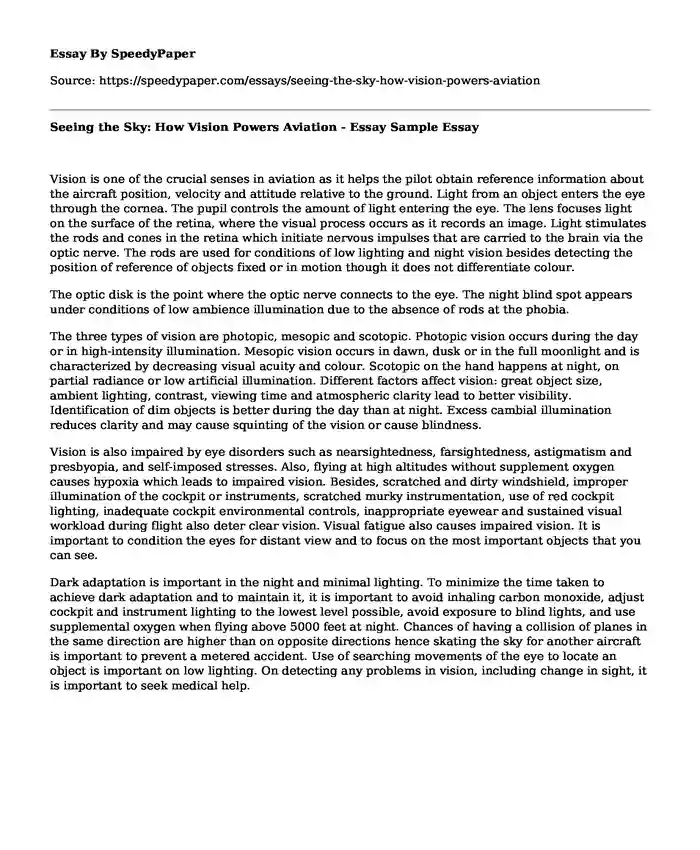Vision is one of the crucial senses in aviation as it helps the pilot obtain reference information about the aircraft position, velocity and attitude relative to the ground. Light from an object enters the eye through the cornea. The pupil controls the amount of light entering the eye. The lens focuses light on the surface of the retina, where the visual process occurs as it records an image. Light stimulates the rods and cones in the retina which initiate nervous impulses that are carried to the brain via the optic nerve. The rods are used for conditions of low lighting and night vision besides detecting the position of reference of objects fixed or in motion though it does not differentiate colour.
The optic disk is the point where the optic nerve connects to the eye. The night blind spot appears under conditions of low ambience illumination due to the absence of rods at the phobia.
The three types of vision are photopic, mesopic and scotopic. Photopic vision occurs during the day or in high-intensity illumination. Mesopic vision occurs in dawn, dusk or in the full moonlight and is characterized by decreasing visual acuity and colour. Scotopic on the hand happens at night, on partial radiance or low artificial illumination. Different factors affect vision: great object size, ambient lighting, contrast, viewing time and atmospheric clarity lead to better visibility. Identification of dim objects is better during the day than at night. Excess cambial illumination reduces clarity and may cause squinting of the vision or cause blindness.
Vision is also impaired by eye disorders such as nearsightedness, farsightedness, astigmatism and presbyopia, and self-imposed stresses. Also, flying at high altitudes without supplement oxygen causes hypoxia which leads to impaired vision. Besides, scratched and dirty windshield, improper illumination of the cockpit or instruments, scratched murky instrumentation, use of red cockpit lighting, inadequate cockpit environmental controls, inappropriate eyewear and sustained visual workload during flight also deter clear vision. Visual fatigue also causes impaired vision. It is important to condition the eyes for distant view and to focus on the most important objects that you can see.
Dark adaptation is important in the night and minimal lighting. To minimize the time taken to achieve dark adaptation and to maintain it, it is important to avoid inhaling carbon monoxide, adjust cockpit and instrument lighting to the lowest level possible, avoid exposure to blind lights, and use supplemental oxygen when flying above 5000 feet at night. Chances of having a collision of planes in the same direction are higher than on opposite directions hence skating the sky for another aircraft is important to prevent a metered accident. Use of searching movements of the eye to locate an object is important on low lighting. On detecting any problems in vision, including change in sight, it is important to seek medical help.
Cite this page
Seeing the Sky: How Vision Powers Aviation - Essay Sample. (2023, Nov 14). Retrieved from https://speedypaper.com/essays/seeing-the-sky-how-vision-powers-aviation
Request Removal
If you are the original author of this essay and no longer wish to have it published on the SpeedyPaper website, please click below to request its removal:
- Gothic Architecture Characteristics
- Classification of the American Tribes - Free Essay in Ethnography
- Learn More about Hospitality Service Experiences from Our Essay Example
- Free Essay on Evolutionary, Physical and Cultural Relationships between Our Species and Neandertal
- Essay Sample on Performance Enhancing Drugs
- Essay Sample on Promotional Marketing Campaign for Savanah Bananas
- Essay Sample on Social Class and Political Power
Popular categories





